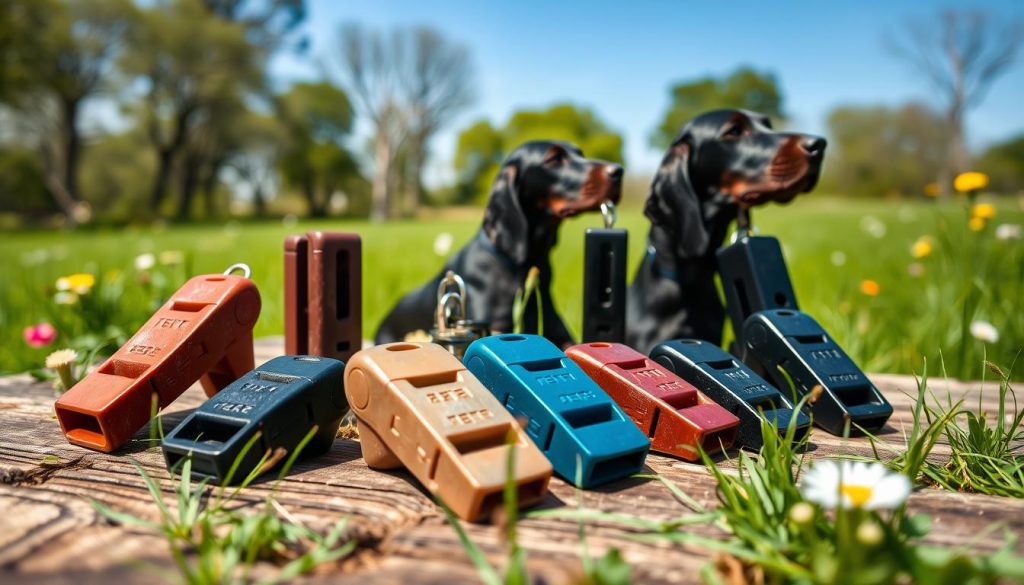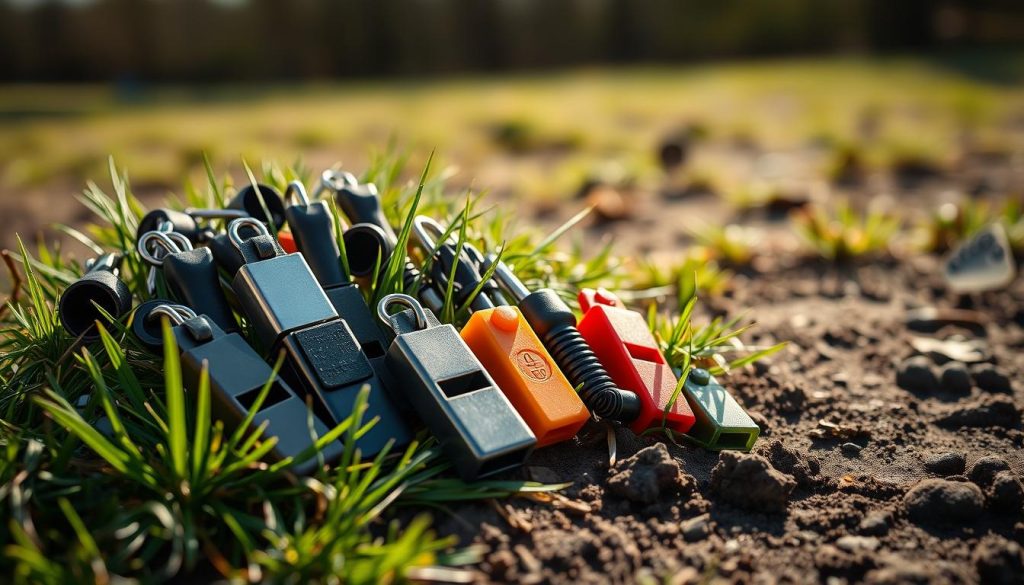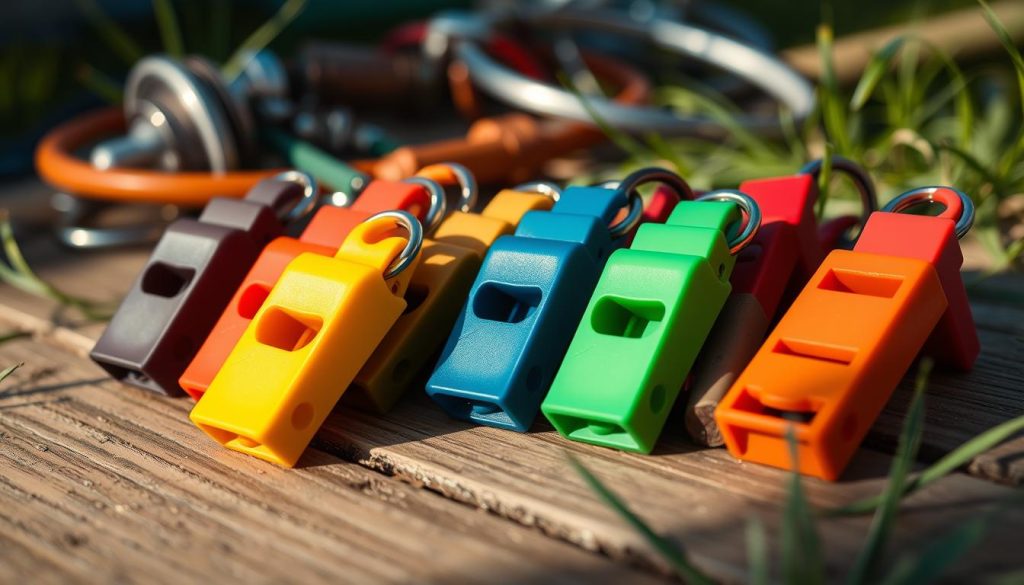I’ve found that setter training whistles really help my dog. They make training easier and improve how well my dog listens. Using these whistles has made a big difference in how my dog responds to commands.
Studies say whistles are great for training dogs. As a dog owner, I use them to get the best from my setter.
Adding setter training whistles to my routine has been a game-changer. They help me communicate clearly with my dog. With regular practice, I’m sure my setter will keep getting better at everything we do together.
Understanding the Basics of Setter Training

Setter training is all about using whistles to talk to dogs. Whistles are great for hunting and outdoor fun. They help dogs and owners understand each other better.
Choosing the right whistle is key. It should be loud and clear from far away. The right tone and frequency are important for getting your dog’s attention. A good whistle makes training more effective.
Why Use Whistles for Training?
Whistles are great for training because they help you talk to your dog from a distance. They’re perfect for hunting and outdoor adventures. But, it takes time and patience for your dog to learn.
Key Benefits of Whistle Training
- Improved communication between dog and owner
- Increased effectiveness in training sessions
- Enhanced bond between dog and owner
Learning about setter training and whistles makes training better for both you and your dog. The right whistle and consistent training help your dog become loyal and well-behaved. It’s great for hunting or just hanging out outdoors.
How to Select the Best Training Whistle for My Setter

Choosing the right training whistle for my setter is important. With many options, picking the best can be tough. Research shows the right whistle can greatly improve dog training.
Features to Look For
Look for a whistle with the right frequency, tone, and durability. It should be loud enough to grab my dog’s attention but not too loud. It should also be easy to use and last long.
Recommended Brands and Models
Brands like Acme and Fox 40 are popular for their quality and effectiveness. Here are some top picks:
- Acme 212 Pro Whistle: A durable whistle with a loud, clear sound.
- Fox 40 Classic Whistle: Easy to use and very effective.
Using the right whistle can make training better. Whether it’s for setters or any dog, finding the right one is key.
Effective Techniques for Using a Setter Training Whistle

Training my setter with a whistle is very effective. It helps me communicate clearly and teach commands. This way, my dog learns to respond fast and right to different commands.
Establishing Commands through Whistles
I start by linking the whistle sound to a command like “sit” or “stay”. I use the whistle the same way every time. When my dog does what I say, I give them treats and praise.
Timing and Consistency in Training
Timing and being consistent are key when using a whistle. I whistle at the exact right moment for my dog to act. I also don’t whistle too much or in a random way. This helps my dog understand the whistle’s meaning.
Common Mistakes to Avoid
Some big mistakes to skip include not using the whistle the same way, not rewarding enough, and not introducing it slowly. By not making these errors, my dog will learn the whistle better. This makes our training better and our bond stronger.
By using these tips, our training gets better and more fun. With regular practice and positive rewards, my dog will quickly learn to respond to the whistle. This makes our training sessions more fun and productive.
Making the Most of Whistle Training Sessions
To get the most out of whistle training sessions with my setter, I focus on creating a positive environment. I use rewards and praise to encourage good behavior. A good whistle is key to communicate clearly with my dog.
Using a hunting dog whistle helps me signal when my dog is doing something right. This builds trust and strengthens our bond.
Research shows a positive training environment improves dog training outcomes. I balance structure and fun in our training sessions. This keeps my dog engaged and motivated, which is crucial for successful whistle training.
Some key tips for making the most of whistle training sessions include:
- Starting with short sessions and gradually increasing the duration
- Using a variety of rewards and praise to keep things interesting
- Being consistent with the whistle commands and signals
By following these tips and using a high-quality hunting dog whistle, I create a positive and effective training environment. This helps me get the most out of our whistle training sessions and strengthens our bond as dog and owner.
| Training Tip | Description |
|---|---|
| Start with short sessions | Gradually increase session duration to avoid overwhelming your dog |
| Vary rewards and praise | Keep things interesting by using different rewards and praise to motivate your dog |
| Be consistent with commands | Use consistent whistle commands and signals to avoid confusing your dog |
Troubleshooting Common Training Challenges
Training my setter with whistle tools has hit some bumps. It’s key to understand my dog’s reactions and tweak my methods. Professional dog training whistles and knowing my setter’s body language help spot what needs work.
Understanding My Setter’s Responses
My setter’s reactions to the whistle tools can change. It’s vital to catch these signs to fine-tune my training. Here are some common reactions:
- Positive signs, like sitting or staying, show my setter gets the commands
- Negative signs, like ignoring the whistle or getting sidetracked, mean my setter needs more practice or a new approach
Adjusting Techniques for Better Results
To get better results, I can tweak my methods. I try different whistles, change the tone and pitch, and add rewards and positive feedback. This makes training more effective for my setter’s unique needs and learning style.
| Training Challenge | Solution |
|---|---|
| My setter is not responding to the whistle | Check the whistle’s frequency and adjust it to a range that my setter can hear clearly |
| My setter is getting distracted during training | Use positive reinforcement and rewards to maintain my setter’s focus and attention |
The Long-Term Benefits of Whistle Training for Setters
Using a setter training whistle has brought many benefits beyond the first training sessions. It has greatly improved our bond. Whistle training has made our communication stronger and my setter more confident.
Strengthening the Bond Between Us
The whistle’s clear sound creates a special connection between my setter and me. Regular use has taught my dog to trust and understand me better. This trust helps us face challenges together, with my setter eager to follow my commands.
Building Confidence and Independence in My Dog
Whistle training has given my setter confidence and independence. They now make decisions and take the lead in different situations. This self-reliance has helped them excel in training and daily life.
Embracing whistle training has opened up new possibilities for my dog. Our bond and my dog’s confidence are priceless. It makes our time together even more special.

